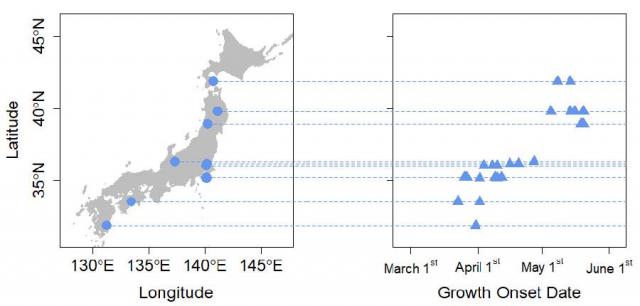Home > Research > Research Results > Research Results 2019 > Difference of seasonal change in growth between north and south Japan
Update:February 6, 2019
Main content starts here.
Difference of seasonal change in growth between north and south Japan: Exploration of the annual rhythm of Cryptomeria japonica D. Don trees
| Article title |
Latitudinal variation in radial growth phenology of Cryptomeria japonica D. Don trees in Japan |
|---|---|
| Author (affiliation) |
Tomohiro Nishizono (a), Kotaro Zushi (b), Takuya Hiroshima (c), Keisuke Toyama (d), Fumiaki Kitahara (e), Fumiko Terada (f), Masahiro Takagi (g), Satoshi Saito (h) (a) Department of Forest Management, FFPRI, Tsukuba, Ibaraki, Japan. (b) Toyama Forestry and Forest Products Research Center, Tateyama, Toyama, Japan. (c) The University of Tokyo, Seto, Aichi, Japan. (d) The University of Tokyo, Kamogawa, Chiba, Japan. (e) Shikoku Research Center, FFPRI, Kochi, Kochi, Japan. (f) Hokkaido Research Organization, Hakodate, Hokkaido, Japan. (g) University of Miyazaki, Tano, Miyazaki, Japan. (h) Kansai Research Center, FFPRI, Kyoto, Kyoto, Japan. |
| Publication Journal |
Forestry: An International Journal of Forest Research, 91(2):206-216, April 2018 DOI:10.1093/forestry/cpx055( External link ) |
| Content introduction |
Trees repeat the rhythm of starting growth in diameter in spring and ceasing growth as winter approaches year after year; thus, gradually growing in diameter. Japan has a long stretch of land in the north and south, which results in regional differences during the spring season; for instance, the flowering of cherry blossoms exhibits a latitudinal gradient northward from the warm southern region. Similar to cherry blossom, we predicted that the onset of growth of the stem of Cryptomeria japonica D. Don trees would proceed from the south to the north and the cessation of growth would occur in the opposite direction. We measured the seasonal change in diameter of several C. japonica forests ranging from the south (Miyazaki city) to the north (Hakodate city) of the Japanese Archipelago. Our results demonstrated that the growth onset date of C. japonica in the south was earlier than that in the north. Conversely, no apparent difference in the cessation of growth day was noted between the south and north, which suggests that C. japonica trees growing in the south tend to grow for a more extended period on an annual scale. This difference in growth rhythm is considered to be the reason why C. japonica trees in the south grow faster than the ones in the north. This study provides significant contributions to the flexible management of C. japonica plantation forests in Japan with its rich seasonality.
|
Copyright © Forest Research and Management Organization. All rights reserved.

